Investing in IPR
31 October 2023

Intellectual property rights is a crucial aspect to ensuring business success.Excel V. Dyquiangco explores the various forms of investing in IPR and explains how investors may gain economic benefits through IP protection, including the risks and challenges.
Intellectual property rights should be a high priority for any successful company. As IPR investments can take many forms, granting IP the high level of importance it deserves leads to a robust and vigorous innovative cycle.
Investing in IPR can come in many forms. It may be as simple as an investment into a holding company by licensing or transacting with an operative company wherein the beneficiary gets a right on increases to the IP valuation through earnings or royalty schemes. For another, it could be to look at a business that is both operative and the owner of IP which is at the forefront. Many consumer companies or technology-enabled companies with strong patents or platform companies that enable downloading music on a subscription basis or streaming videos, such as Netflix, can fall into this category.
A third kind of investment is where IP is funded through only claims in royalties limited to that IP through an agreement where the IP serves as collateral. A fourth form of funding could be a pledge or a loan against the IP with a lending organization duly backed by agreements. And still another form of funding could be through escrow accounts, which are dependent upon certain contingencies that may be contractual and stem from IP.
The importance of IPR investments
According to Rusmaini Lenggogeni, a partner at SSEK Law Firm in Jakarta, innovators may wish to invest in IP to derive IP rights over the innovations in question.
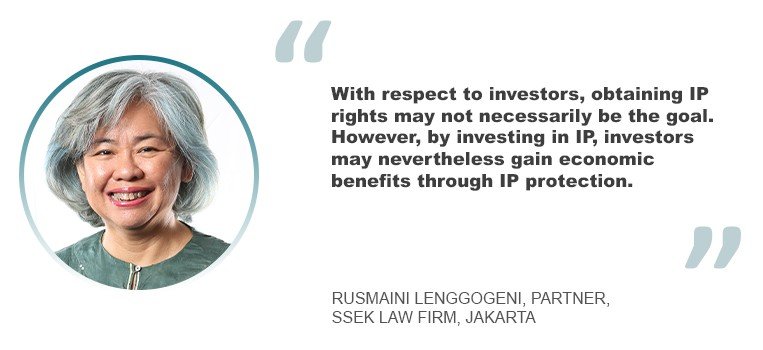
“An example is to obtain patent rights or trade secrets over such innovations,” she says. “These rights would then give the innovators exclusive rights to make, use, sell, import, lease or otherwise make the IP available to commercialize, either themselves or by granting licenses to other parties.”
She adds: “With respect to investors, obtaining IP rights may not necessarily be the goal. However, by investing in IP, investors may nevertheless gain economic benefits through the protection of the IP. For example, a party investing in developing an invention that would qualify for patent protection would receive a lucrative return once the patented invention is commercialized. Or someone investing in an IP-driven start-up would reap the rewards of the investment once the start-up establishes its trademark’s reputation through continuous protection and advertisement, consequently enhancing its market and bringing in customers.”
For Safir Anand, a senior partner and head of trademarks at Anand and Anand in Noida, there has been a constant awareness of the growth of the intangible value of assets across the world.
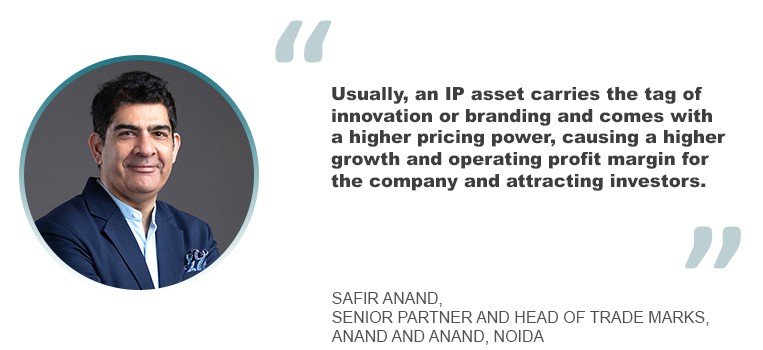
“This is stemming from the fact that such assets do not carry the burden of heavy capital-intensive businesses and are considered to be asset-light and cash-rich,” he says. “Moreover, there may be a situation where the ability of these assets to move from a ‘building’ model or an investment model into a ‘revenue’ or a cash generation model may happen by virtue of either subscriptions or licences or collaborative business models and the return on capital employed (ROCE) may be significantly higher as opposed to depreciating assets such as buildings or assets at the risk of write-offs such as inventory.”
He adds: “Usually, an IP asset carries the tag of innovation or branding and comes with a higher pricing power, causing a higher growth and operating profit margin for the company and attracting investors. In the case of start-ups, the interest stems from the ‘capability’ of the IP and the potential of ‘scalability’ stemming from usually a basic idea with some basic protection that lacks business acumen and needs funding to explore other avenues including collaborations, recruitment of talent and channelizing of revenue and profit streams.”
In the case of organizations such as research and development, he says there is a tendency in the investment community to shun investments as sometimes the gestation period may be higher and, in the short run, there may be a higher expenditure on IP creation rather than profits. Consequently, specialized business models such as SPVs or funds with a longer gestation period may be attracting fear versus immediate short-term investments.
“There is also a fourth instance where the IP may be sound but the owner has not explored the ability to cross-sell or co-license, and thus, to the investor, there may be a huge missing potential,” he says. “A clear example in the past was Disney’s acquisition of rights from George Lucas and conversion of the same into merchandise from films.”
The risks and challenges
The first question the IP investor needs to ask is whether a particular innovation falls under any IPR subject matter and, if so, which type of IP would best protect said innovation.
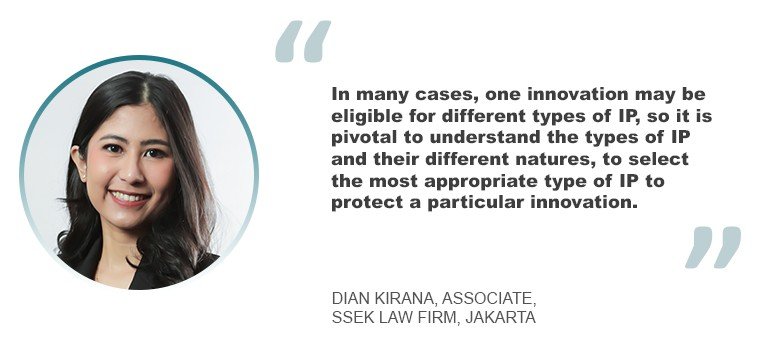
“In many cases, one innovation may be eligible for different types of IP, so it is pivotal to understand the types of IP and their different natures, to select the most appropriate type of IP to protect a particular innovation,” said Dian Kirana, an associate at SSEK Law Firm in Jakarta. “For example, if investors wish to invest in new technology, it would be prudent to assess whether to pursue patent protection or trade secret protection. They may consider that patent protection is limited – 20 years for a general patent and 10 years for a simple patent, not to mention the lengthy process to obtain the patent protection and the annual fee. Whereas, if the investors opt to protect the new technology as a trade secret, they can hope for perpetual protection for as long as the information regarding such technology has economic value, is confidential, and maintains its confidentiality.”
However, she advised that, with technology always changing and moving forward, protecting a new technology as a patent might be more beneficial to the patent holder because the technology may not retain its economic value over time. In such a case, it would be more advantageous for the patent holder to commercialize its patent while the protection period persists.
Further, she says, by obtaining a patent right, the patent holder may benefit from the advancement of its technology if the use of such advanced technology involves the use of the underlying technology, which would require the newer technology patent holder to obtain a license to use the underlying technology.
Kirana added that the same technology may also be eligible for industrial design rights if it has aesthetic features worthy of industrial design protection. The technology may also be sold under a certain name that can be protected as a trademark.
IP investors should also consider the registrability or eligibility of innovation for types of IP. Even if an invention falls into the subject matter of patent protection, it may not be eligible for protection if, for example, the novelty of the technology was anticipated by the prior art or if such technology has been disclosed to the public before the patent filing date. Even if an insignia or logo falls into trademark protection, it may not be eligible for protection if a similar trademark is already in the trademark registry.
“When considering registrability, the IP investor should also assess the infringement risk against a third party’s IP rights,” she says. “Using, making, or otherwise commercializing one’s invention, logo, work, design, or other IP subject matters before obtaining the IP protection would risk infringing third parties’ IP rights. This would give rise to the IP holder’s claim for damages, claim to terminate the use, and even the claim for criminal sanction.” (IP-related offences in Indonesia are complaint-based offences.)
To mitigate such risks, IP investors must first understand the nature of the different types of IP so they can choose the best and broadest protection over the innovation. It would then be advisable to conduct prior clearance searches to gain a better understanding of the possible registrability of the innovation and the risk of infringing a third party’s IP rights.
It is also sensible for IP investors to conduct a prior market assessment to get an idea of how the IP can be commercialized and the potential revenue it can generate.
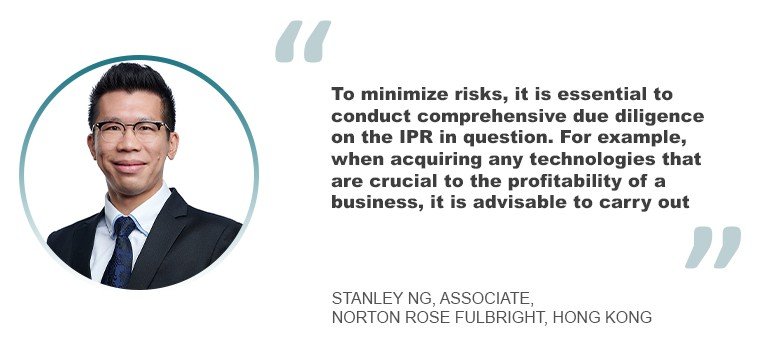
“To minimize the above risks, it is also essential to conduct comprehensive due diligence on the IPR in question,” adds Stanley Ng, an associate at Norton Rose Fulbright in Hong Kong. “For example, when acquiring any technologies that are crucial to the profitability of a business, it is advisable to carry out professional searches on patentability and freedom to operate.”
Legal developments in investments
Jeremiah Chew, an associate director at Ascendant Legal in Singapore, said that the ease of IPR enforcement is an important factor affecting investment decisions.
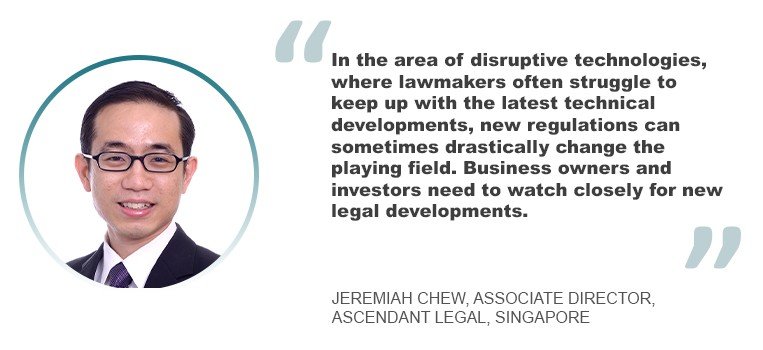
While the principles of IPR protection are, to a certain extent, similar across many developed countries, the practical steps for judicial enforcement can be “very different.” Changes in the civil procedure rules and practices – concerning the formality requirements for litigation documents, the burden of proof and the length of time to get to a first-instance decision – may impact business decisions on whether to invest in a particular jurisdiction.
“In the area of disruptive technologies, where lawmakers often struggle to keep up with the latest technical developments, new regulations can sometimes drastically change the playing field,” he said. “Business owners and investors need to watch closely for new legal developments, including those regulating a specific new industry and those affecting a broad range of industries.”
Nowadays, with the global development of the law on intellectual property, the legitimate rights and interests of the owners of IP assets have been highly protected.

“The reality clearly shows that the law on IP is increasingly open to international investors and encourages creative entities and businesses to invest more in the protection of IPR,” said Do Ba Thich, a senior partner at ASL Law in Hanoi. “Along with the legal developments, several points will affect the vision, activities and how companies allocate their resources, such as the rules on the exclusive protection of intellectual property.”
“When an entity holds an exclusive on a certain product, especially inventions or patents which create products that are difficult to replace, it leads to exclusivity on price,” he explained. “This was very evident in the early period of the Covid-19 pandemic when only a few major pharmaceutical companies in the world could research and produce vaccines, which led to a price exclusivity where the selling price per dose of vaccine was extremely high. As a result, there was not an even distribution of the world quantity of vaccine.”
He added: “To ensure the interests of the majority, so in cases of pandemics like these, many countries have limited this monopoly so that more people can access vaccines to protect their health. Thus, along with the development of law, the owner’s monopoly over their intellectual property will also be limited in many cases for the majority and may make them afraid to invest in areas like pharmaceuticals in the future.”
In addition, the lack of deterrence law enforcement in dealing with counterfeit goods, fake brandings and IP infringement acts makes foreign investors not want to invest in the Vietnam market and, instead, move to other markets for better protection of their interests.
Reception to investments from Asian countries
In Indonesia, the start-up scene is booming, with many IP-driven companies, which means there is a need for financing through investment.
“More companies are realizing that intangible assets are as important, if not more important, than traditional assets,” says Lenggogeni. “A target entity’s IP portfolio and the projection of how those IPs are to be commercialized have become significantly more important. And innovators with ideas but insufficient resources to realize them rely on investors to finance and commercialize their innovations.”
Meanwhile, the Singapore government is highly supportive of IP investment and has put in place a 10-year IP master plan that ends in 2023, which aims to develop Singapore as a global IP hub in Asia. Under this master plan, Singapore aspires to be a hub for IP transactions and management, quality IP filings and IP dispute resolution.
“The Singapore government has implemented a wide range of incentives to encourage companies and innovators to invest in IP,” said Chew. “For instance, the Intellectual Property Office of Singapore has launched a fast-track program to accelerate the processing of IPR applications in Singapore that meet certain requirements. Government grants are also available for small and medium Singaporean enterprises that wish to file IPR applications in overseas countries for market entry. Attractive tax incentives are also offered for IP-related projects. The overall R&D supportive atmosphere established legal system and mature IP registration regime in Singapore also encourages companies to build up their IP portfolio there.”
For over 16 years, Vietnam has continuously improved the IP protection system such as amendments to the law on intellectual property. Recently, in April 2021, the government coordinated with the Ministry of Science and Technology to organize an “Intellectual Property Law – Limitations, inadequacies, and orientations for amendments and supplements” workshop to actively promote innovation and national scientific and technological research.
Besides the amendments to the law on intellectual property, the prime minister has also issued an Intellectual Property Strategy for 2030 with tasks and solutions to raise awareness among leaders at all levels, sectors, localities and society about the importance of improving the exploitation efficiency of IP. As a result, many localities have issued plans to implement the Intellectual Property Strategy in the area and implemented integration with specific socio-economic development policies of the locality.
“As Vietnam becomes more integrated globally, in part through its free trade agreements, IP rights will become an even more important factor in how organizations view the business climate in Vietnam, particularly as the country’s economy and technology continue to develop,” said Thich. “Fortunately, Vietnam is keen to develop and work on its IP laws to help push it further in the global economy.”
Meanwhile, in India, there has been a constant growth of start-ups; more than 100 of these start-ups have now moved to unicorns status. In most of these examples, a disruptive business model works through IP either in a brand or technology with the effect of longevity. It is not the case with established companies and their established brands that they struggle with brand valuation because cash streams are well defined from past performance, and the ability to innovate appears to be more anti-disruptive than in a start-up model.
“For example, an established company can easily go to a banker to buy or sell a brand while a start-up may need more legal help in convincing an investor on the valuation, which may at times also skew from reasonable to excessive due to euphoria around the disruption,” said Anand. “Time and again, more and more interest is moving towards IP-based companies, including data-centric and-cloud sourced businesses or businesses with sound technologies. The struggle in India, however, appears to be more with algorithms and the inability to protect them under patents, which requires the law to be re-looked into or innovative lawyers to capture this in an agreement that can be duly enforced and where damages can be quantified.”






